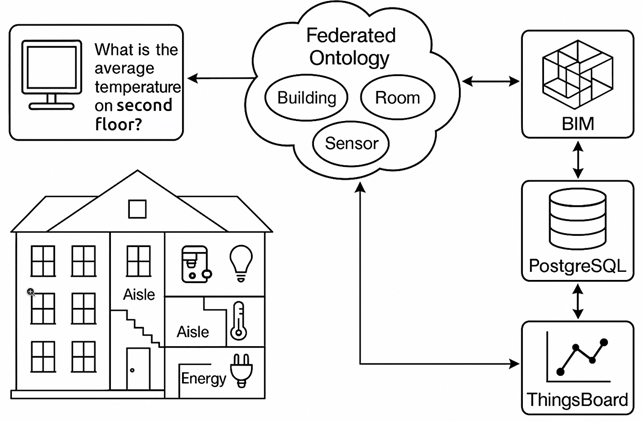
BIM + Ontologies: A way to create abstraction on datasets
The development of a federated ontology for knowledge representation in smart building environments emerges as a natural and strategic extension of the goals pursued within the DIGEST project. DIGEST is centered on creating advanced digital infrastructures that facilitate decision-making processes through the intelligent integration of data, technologies, and knowledge. In this context, the proposed ontology framework contributes directly to the project’s ambition by enabling a higher level of semantic understanding and interoperability across heterogeneous data sources within the built environment.
Modern buildings generate vast amounts of data from diverse sensor networks that monitor environmental conditions, energy consumption, occupancy, and operational status. However, this data is often siloed—stored in isolated platforms like ThingsBoard or captured through specialized Building Information Modeling (BIM) tools—making it challenging to derive actionable insights at the system level. The proposed federated ontology addresses this limitation by introducing a unified semantic layer that integrates spatial representations from BIM with dynamic sensor data stored in relational databases, such as PostgreSQL, via ThingsBoard.
This semantic framework will allow the system to answer complex, high-level queries such as:
- “What is the average temperature in all meeting rooms on the second floor over the past week?”
- “Which building areas show abnormal energy consumption patterns relative to their occupancy?”
Through the combination of existing ontologies—including BOT for building topology, IfcOWL for detailed geometric data, SOSA/SSN for sensor observations, and QUDT for units of measurement—the solution supports both fine-grained analysis and aggregated reasoning. This capability is directly aligned with DIGEST’s objective of developing intelligent digital twins and knowledge-driven platforms that support prescriptive analytics and optimized resource management.
Moreover, this ontology-driven approach fosters interoperability, allowing the integration of existing and future systems without requiring extensive reengineering. By utilizing standards like R2RML or Ontop, relational data from ThingsBoard can be virtually exposed as RDF, enabling semantic queries across federated data sources. This ensures that the system remains scalable and adaptable to evolving requirements, a core principle of the DIGEST initiative.
In essence, this federated ontology serves as an enabler for the digital transformation of building management, providing the semantic backbone needed to transition from data collection to actionable knowledge. It empowers stakeholders to perform advanced reasoning over spatial, temporal, and contextual data, thereby supporting the intelligent decision-making processes that lie at the heart of the DIGEST project’s mission.

